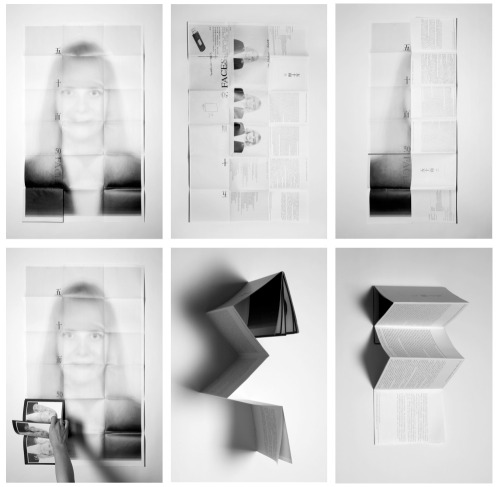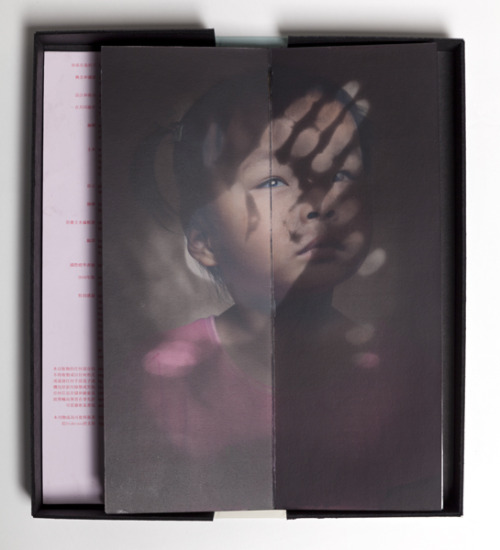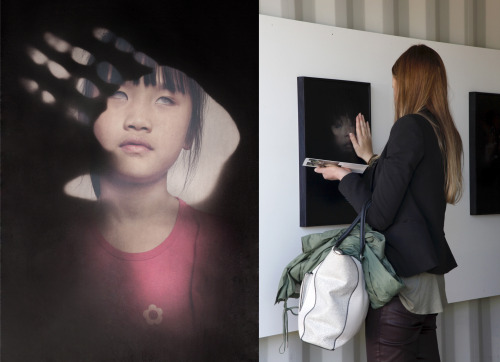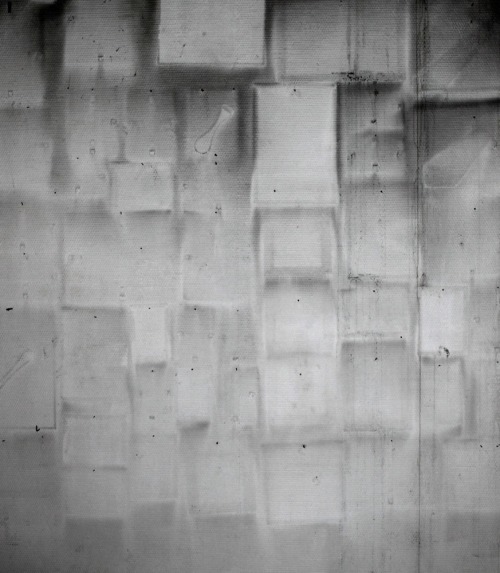
© Carina Hesper, ‘Pigment’ print, Laura, 2012
What was your educational path and how did it influence you?
Carina Hesper (CH): After studying fashion design for two years I switched to the fine art department of the ArtEZ School of the Arts in Arnhem, the Netherlands. At the fine art department I focused on lens-based media. I call myself a visual artist rather than a photographer. Currently I work a lot with photography to develop my concepts and ideas but in the near future it could also be video and new media only.
During my years of studying fashion design, my love for great design in general was born. Even though I studied fine art afterwards, I still love design as much as I love art. I believe my work is in between art and design, and the fact that my school focused mainly on design - with fine art as the smallest department - influenced me for certain.
Is there any teacher or fellow artist that has allowed you to better understand your work?
CH: Many teachers helped me to understand my work better, like Marnix de Nijs and Korrie Besems. But also many artists, designers and photographers influenced me. If I see a work that both conceptually and design-wise is perfectly developed, I intuitively feel that it is the language I am also speaking. To me people who speak this language for example are designer Christien Meindertsma with her book ‘Pig 05049′, fashion designer Hussein Chalayan’s collections and creative approach in general and also Anish Kapoor’s work Ascension on the Venice biennale of 2011; furthermore, the exhibition- and book ‘UMBRA’ by Viviane Sassen and Guido van der Werve’s ‘Number 8’.
A photography project I greatly admire is Angélica Dass ‘Humanae’. And I love everything musician Stromae puts his mind on. The music is great, the video clips are amazing and he even thought of his clothes and made a collection out of it. And behind all this is his mission to talk about social issues like alcoholism, cancer and depression in daily life.
How would you describe your work in general? What kind of photographer are you?
CH: I aim to connect with the viewer through the portraits I make. Sometimes by capturing my own (possibly manipulated) face, but also by working with people with a special or marginal position in society. Often this results in works of art that are confrontational rather than comfortable, compelling the viewer to take a stand, and to reflect on social issues and developments.

© Carina Hesper, ‘50 Faces’ book
You are now working on a book called ‘Like A Pearl In My Hand’. Can you tell us about this project?
CH: In my ‘to be’ book ‘Like a Pearl in my Hand’, I reveal a side of China that is mostly hidden from the outside world. Many parents in China give up their newborn child when they find out that the child is visually impaired. This is a consequence of the One-Child policy (formally ‘relaxed’ in 2013) and the loss of face associated with having a child with a disability. Touched by these children’s fate, I visited different locations of the Bethel orphanage in Beijing, where I photographed children with a visual impairment. The more time I spent with these children, the less I saw their disability. That is why I wanted to photograph them in their unique way. Just as children, not as victims.


© Carina Hesper, ‘Like a Pearl in my Hand’, prototype book, 2015

© Carina Hesper, ‘Like a Pearl in my Hand’, installation and photo at Unseen 2013
‘Like a Pearl in my Hand’ will be presented as a limited and signed edition book. The book will contain 32 portraits, all fully coated in black thermo-chromatic ink. This ink gets transparent when the temperature exceeds 25 degrees Celsius. So when you touch the black page with a warm hand, the underlying portrait of the visually impaired child is revealed. This way, form and content are brought together in a unique and interactive way; the blind children, their concealment from society and the touch that is needed to see their portraits. The reader experiences what it is like to be without sight and becomes actively involved in the fate of a group of vulnerable children. The book adds a tangible dimension to the medium of photography – a medium that is predominantly about seeing and being seen.
What role does the passing of time play in your work?
CH: Time always plays a different role in my work.
In my series ‘Black Fire, White Ashes’, which are abstract colour pictures of burned down houses, I am mainly interested in the temporality of the location in this state. As soon as it is renovated, you will never find it back.

© Carina Hesper, ‘Black Fire’, White Ashes. Memory of a Life, 2010
My series ‘Pigment’ is about the changing colour of the paper and the photograph itself after putting it in the sun for some time. The colour pink disappears more and more, depending on the amount of time that you expose it to the sun.
In ‘Portrait Series No.1′ it takes about 5 seconds before the portrait starts following you with her eyes. If you pass it quickly, nothing happens.
And in my project and book ‘Like a Pearl in my Hand’ it is about the experience, effort and time that it takes to reveal the portrait underneath the black thermo chromatic ink.
You have made an app, an interactive book. Are you specifically looking for new ways to present photography?
CH: If I am developing new work, I always try to find the right medium and form that perfectly fits my concept. For my app ‘Portrait Series No.1′ I collaborated with V2_Institute for the Unstable Media. The idea was to develop a modern Mona Lisa, inspired by my own transgender brother. ‘Portrait Series No.1′ is an interactive portrait that plays with the human gaze and behaviour. Related to old oil paintings and to photography, this portrait focuses on androgyny; the fine line between masculinity and femininity. The work questions how we look at art, which usually is patient to be looked at. I like the subtleness of the work.
It is great that by creating an app, my art is available to everyone in the world, because of the app store and the very affordable price. You can literally ‘bring it home’, after seeing it live-size in an exhibition. This work will be developed in a series of more interactive portraits based on human behaviour in the near future. So yes, I am interested in new ways to present photography, but I am not very aware while doing so. This is my language and I like the viewer to be very much involved.
Can you give us an insight in your day-to-day working life? Do you spend most of your time in your studio or out photographing or doing other things? Do you have any rituals that help you to be creative and productive?
CH: For example, today I started with sending some important emails. After that I travelled to Amersfoort, the Netherlands, to attend a meeting of ‘Make a Memory’. Afterwards I travelled back to Rotterdam. Had dinner. In the evening I continued writing a workshop text and writing this interview.
On a daily basis, I try to be in the studio as much as I can, but if I am working on computer-related stuff I also love to work from home. Now I am mainly focusing on making my Kickstarter campaign for my book ‘Like a Pearl in my Hand’ a successful one. This means I am working on texts, press releases, approaching companies for support, trying to give as many talks as possible and send a lot of emails. Maybe not very creative, but an important part of my job. In the meantime I am preparing for my exhibition at the Schiedam Photo festival this month.
© Carina Hesper, ‘Like a Pearl in my Hand’, video
In January 2016 I am planning to travel again. During this time my focus will be researching, photographing and developing new work. Every day is a different day.
My rituals besides art are doing ballet, yoga, running and power workouts and learning Chinese. I am sportive, and I like the fact that you are in control when you learn a language. Completely different than in art, where you only have control on working your ass off.
In your opinion, what is the hardest part about being a photographer? And what is the best part?
CH: The hardest part is that you need to motivate yourself every day and really need to believe in what you do, even if it is tough and nobody believes in what you are doing. The best part is that I travel to great places and meet extraordinary people. I can choose every day what I do or work on. Making my ideas and dreams come to life makes it all worth it.

© Carina Hesper, Sketch ‘Pigment’, 2015
What projects are you currently working on and what are your plans for the future?
CH: Besides my book ‘Like a Pearl in my Hand’, I am currently working on finishing my series ‘Pigment’ in an installation and book. And I will be further developing my series ‘Lucky Flowers’ in China. My plans for the future are to work on another project with thermo chromatic- or interactive ink, and to do more collaborations with people and institutes like V2_.
---
LINKS
Carina Hesper
App Portrait Series No.1′
The Netherlands
share this page